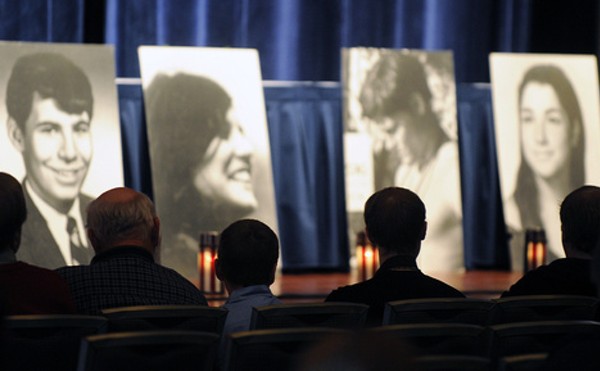
All this thievery results in a brilliant work of art.
Molière was influenced by the Italian commedia dell’arte theater style, in which actors portray stock characters wearing masks. Le Petomane carries on the tradition and serves it up in heaping helpings.
As the play begins, the six-member troupe parades across the stage displaying their masks and various costumes to introduce the audience to the show. The costumes consist of various screen-printed aprons over puffy white shirts, and knickers with white stockings and black shoes. The masks cover half the face and serve to remind that we all wear them.
They all look scary. Don Juan’s mask is red, like the devil he is. His nose is long and pointy. His servant, Sganarelle, has a mask that evokes the modern tramp clown.
The rapscallion Don Juan, in a twist here, is played by a woman (Abigail Bailey Maupin). Her skill succeeds in making her character believable. When Don Juan strolls across the stage expounding about feminine beauty, she cleverly catches the eye of each woman seated along the front row, holding the glance long enough to make her feel special. It’s easy to see why all the ladies loved Don Juan, with the way the word “sinful” rolls deliciously off Maupin’s tongue.
Gregory Maupin plays Sganarelle, the peon worker bee who knows where his bread is buttered. As the Bob Hope-like, obsequious servant, he is the perfect foil. His moves mimic those of a classically trained dancer. He often stands ludicrously frozen in open-mouthed shock when his libertine master spouts blasphemies. At times he tries to warn young peasant girls about Don Juan’s “love ’em and leave ’em” proclivities. But as Don approaches, he hilariously changes his tone with perfect comic timing, saying nervously, “My master is a fine, fine man, with no intention whatever of soiling you and, and you, and, or anyone.”
All the actors move about like marionettes while spouting witty dialogue in unusual accents. Charlotte (Kristie Rolape) and Pedro (Kyle Ware) as Molière’s peasants even adopt rural Southern accents. But the “Beverly Hillbillies” accent isn’t the only modern element. Like many current politicians, Molière’s Don Juan was a hypocritical nobleman who hid behind the mask of piety. Maupin’s Don Juan joins the ranks of “those who have managed to cover the sins and excesses of a misspent youth by wrapping themselves in a cloak of holiness, a cloak that offers true freedom; freedom to do any evil they choose.”
Sound like anyone you know?
In the end, Don Juan pays for his sins, a move that pleases the audience and upholds a higher moral code. But in real life, not all sinners truly pay for their deeds. Many ignore moral codes and gain greater power. Are we genetically programmed to follow these leaders?
I think I hear Molière’s ghost laughing.





